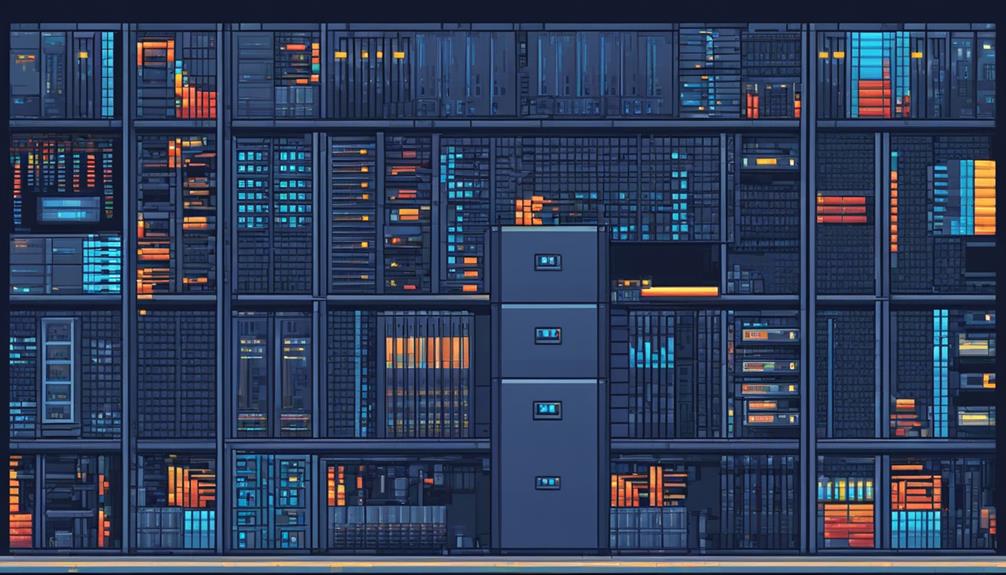In the realm of data centers, where uninterrupted power is crucial for the smooth functioning of critical operations, backup power systems play a pivotal role. The importance of maintaining continuous power supply cannot be overstated, as even a momentary power outage can have far-reaching consequences, such as work disruptions, delayed decision-making, and damage to a company's reputation.
Data center operators stand to lose not only valuable time but also valuable customers if they experience downtime. Therefore, it becomes imperative to have backup power systems in place that are properly sized, with redundant power distribution units to avoid any single points of failure.
Typically, these backup systems rely on generators to provide power when utility power is lost. Ensuring a reliable backup power system is not only crucial in preventing system downtime but also safeguards against the loss of critical data.
Key Takeaways
- Uninterrupted power supply is crucial for data centers to prevent work disruptions, delayed decision-making, and damage to reputation.
- Backup power systems, such as UPS systems and backup generators, play a critical role in maintaining continuous operation of data center components.
- Choosing the right type of backup power system ensures uninterrupted operations and protects valuable data.
- Factors such as power capacity requirements, redundancy, reliability, maintenance, and monitoring should be considered when selecting a backup power system for a data center.
Importance of Backup Power
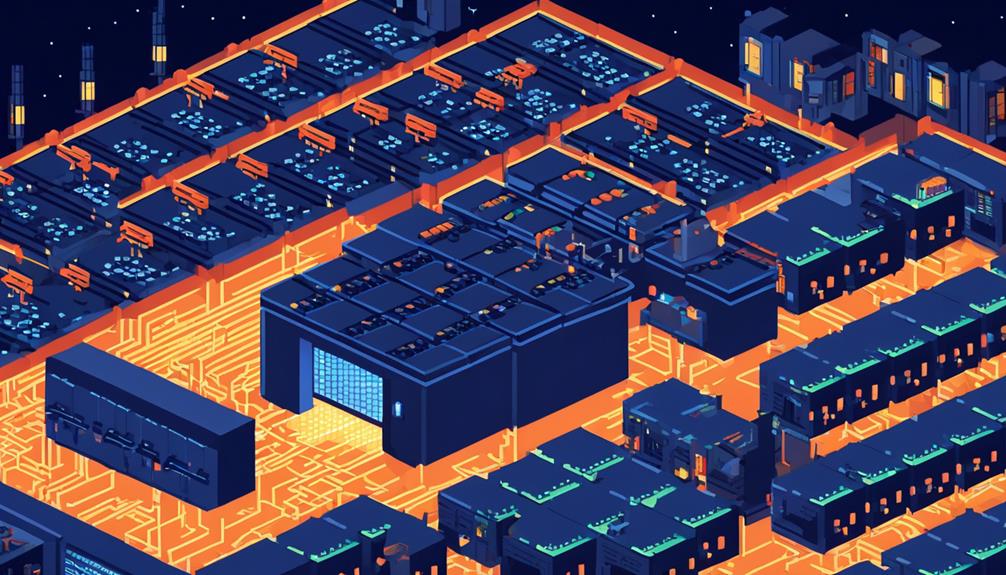
Backup power is of utmost importance in data centers to ensure uninterrupted power supply to critical components. Power interruptions can have serious consequences such as system downtimes and loss of in-process information. Data center backup power is essential to prevent system restarts and corruption of parts during power interruptions. Interruptions in the main power source can cause startup issues and loss of critical data in data centers. Therefore, having a reliable backup power system is crucial for maintaining the continuous operation of data center components.
One key component of data center backup power is the use of UPS systems. UPS stands for Uninterruptible Power Supply, and it provides backup power during power outages or fluctuations. UPS systems are designed to instantly detect any disruption in the main power supply and automatically switch to the backup power source. This ensures a seamless transition and prevents any disruption in the power supply to critical components.
Another important element in data center backup power is the automatic transfer switch (ATS). The ATS is responsible for transferring the power source from the main supply to the backup generator or UPS system when it detects a power interruption. This automatic transfer ensures that there is no delay in power supply and critical components continue to receive uninterrupted power.
Backup generators play a crucial role in data center backup power as they provide power during extended outages. These generators are designed to supply power for an extended period, ensuring the continuous operation of data center components until the main power supply is restored.
Types of Backup Power Systems
One essential aspect to consider when implementing backup power systems in data centers is the different types of solutions available. Choosing the right type of backup power system is crucial to ensure uninterrupted operations and protect valuable data. Here are four types of backup power systems commonly used in data centers:
- Static UPS systems: These systems utilize batteries to store electrical energy. When there is a power outage, the batteries provide immediate power to keep the data center running until the primary power source is restored. Static UPS systems are reliable and provide seamless power transfer, making them ideal for protecting sensitive equipment in data centers.
- Dynamic UPS systems: Unlike static UPS systems, dynamic UPS systems store energy in rotary masses. These systems convert electrical energy into kinetic energy, which can be rapidly converted back to electrical energy when needed. Dynamic UPS systems are known for their high energy efficiency and ability to handle sudden load changes, making them suitable for data centers with fluctuating power demands.
- Diesel gensets: Diesel generators offer the best long-term solution for power stability and resilience. These systems are capable of supplying continuous power for extended periods, ensuring uninterrupted operations even during prolonged power outages. Diesel gensets are highly reliable and can handle the high power demands of data centers.
- Generators with backup power: This type of backup power system relies on a generator that ensures no disruption or outage. The generator is connected to an automatic transfer switch that detects any power loss and automatically starts the generator to provide backup power. This setup is commonly used in data centers where even a momentary power interruption can have severe consequences.
Implementing the right type of backup power system is crucial for data centers to maintain operations, prevent system downtime, and protect valuable data. By considering the specific power requirements and load demands of the data center, organizations can choose the most suitable backup power system to ensure uninterrupted operations and minimize the risk of data loss.
Benefits of Uninterrupted Power Supply
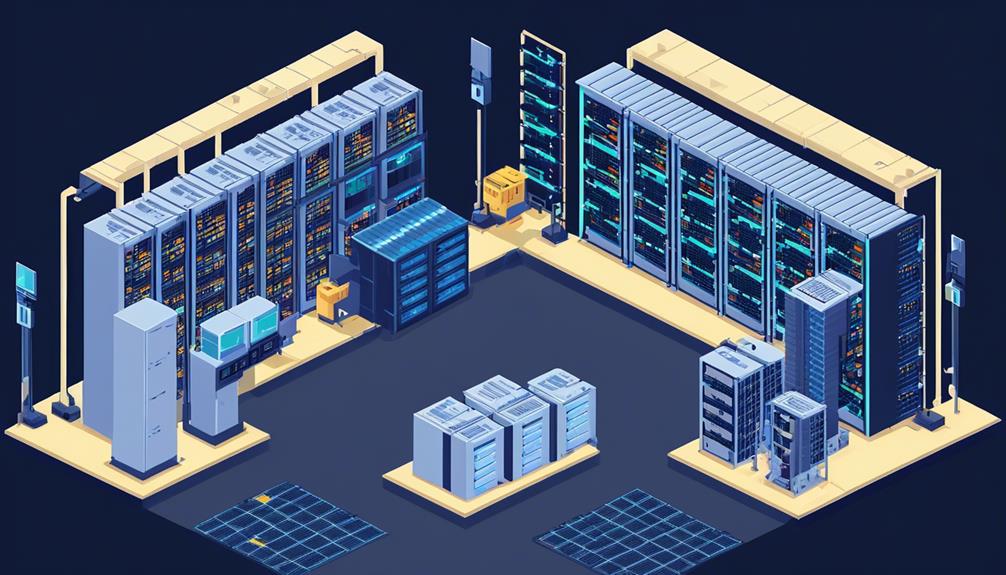
Uninterrupted Power Supply (UPS) systems offer several benefits to data centers, including power redundancy and the ability to maintain continuous operations.
By providing backup power in the event of an outage, UPS systems ensure that critical servers and equipment remain functional, minimizing the risk of downtime and its associated financial and reputational consequences.
With UPS systems in place, data centers can confidently handle increased load demands and maintain the uninterrupted flow of power to vital components, preventing data loss and ensuring reliable operation.
Power Redundancy
Power redundancy provided by Uninterrupted Power Supply (UPS) systems ensures continuous and reliable power supply to critical components, minimizing the risk of system downtime and potential data loss.
Here are four key benefits of UPS power redundancy in data centers:
- Protection from outages: UPS systems protect servers from catastrophic downtime, reducing financial and reputational risks associated with data center outages.
- Seamless integration: Backup power redundancy provided by UPS systems integrates seamlessly into data center infrastructures, delivering consistent and efficient power to support 24/7 uptime demands.
- Elimination of single points of failure: Reliable UPS systems with multiple power distribution units and generators eliminate single points of failure, ensuring no disruption or outage during utility power loss.
- Scalable and modular solutions: UPS systems offer scalable and modular solutions, allowing data centers to adjust quickly to changing power requirements and provide redundancies to support increased load demands.
Continuous Operations
To ensure continuous and reliable power supply in data centers, uninterrupted power supply (UPS) systems play a crucial role. They safeguard critical components and minimize the risk of system downtime and potential data loss. UPS systems protect against power spikes and provide backup power during outages. This ensures that critical components remain powered.
These systems integrate seamlessly into data centers and work in conjunction with emergency generators to provide uninterrupted power supply. Interruptions in power can have serious consequences, including system restarts, corruption of information, and loss of in-process data.
Factors to Consider in Choosing Backup Power Systems
When choosing backup power systems for data centers, it is important to consider several factors.
Firstly, power capacity requirements must be carefully assessed to ensure that the system can adequately meet the facility's energy demands.
Additionally, redundancy and reliability are crucial to minimize the risk of power outages and ensure continuous operation.
Lastly, maintenance and monitoring should be taken into account to ensure the system remains in optimal condition and any potential issues are promptly addressed.
Power Capacity Requirements
In determining the appropriate backup power system for a data center, it is crucial to carefully assess the power capacity requirements to ensure effective and reliable operation. Here are four factors to consider when evaluating power capacity requirements:
- Calculate the total power consumption of the data center, including all servers, networking equipment, and cooling systems. This will help determine the minimum power capacity needed for the backup system.
- Take into account future growth and expansion plans. It is important to anticipate any potential increases in power consumption and ensure that the backup power system can accommodate these future needs.
- Consider redundancy and fault tolerance. Multiple power distribution units can help avoid single points of failure and ensure uninterrupted power supply in case of equipment failure.
- Evaluate the reliability and capacity of the backup generator. The generator should have sufficient capacity to support the entire data center during extended power outages, and regular maintenance should be performed to ensure its optimal performance.
Redundancy and Reliability
Redundancy and reliability are critical factors to consider when choosing backup power systems for data centers.
Redundancy in backup power systems involves having multiple layers of backup power to ensure uninterrupted power supply. This can be achieved by implementing redundant components such as multiple generators, UPS units, and power distribution units.
Reliability is crucial to prevent system downtime and ensure continuous operation. To enhance reliability, factors like the capacity of the backup system and the presence of multiple power distribution units should be considered.
The use of generators in backup power systems is essential to avoid disruption or outage during power failures. Reliable backup power systems are critical for data centers to prevent data loss, system downtime, and the resulting financial impact.
Maintenance and Monitoring
To ensure the reliability and continuous operation of backup power systems for data centers, careful consideration must be given to the maintenance and monitoring of these systems. Here are four key factors to consider:
- Regular Maintenance: Performing regular maintenance is crucial to ensure that backup power systems are in optimal condition. This includes tasks such as testing batteries, inspecting electrical connections, and verifying the functionality of components like automatic transfer switches and uninterruptible power supplies.
- Monitoring Tools: Having access to monitoring and diagnostic tools is essential for tracking the condition and performance of backup power systems. These tools can help identify potential issues before they escalate into emergencies, allowing for timely intervention and maintenance.
- Remote Monitoring: Remote monitoring capabilities enable data center operators to monitor backup power systems from a central location. This allows for proactive identification of potential issues, reducing the risk of downtime and data loss.
- Ease of Maintenance: Choosing backup power systems that are designed for ease of maintenance can streamline the upkeep process. Components that are easily accessible and serviceable can reduce the time and effort required for maintenance tasks.
Maintenance and Testing of Backup Power Systems
Regular maintenance and testing of backup power systems are vital to ensure their reliability and performance during power outages. Testing should include load bank testing, where an artificial load is applied to the backup power system to verify its capacity and performance. This test is essential to assess the system's ability to handle the expected load during an actual power outage. Regular inspections of batteries, fuel systems, and electrical components are also crucial to identify and address potential issues before they cause system failures.
Maintenance activities should encompass cleaning, lubrication, and calibration of components to ensure optimal performance and extend the lifespan of the backup power system. Batteries should be regularly inspected for signs of corrosion or deterioration, and fuel systems should be checked for leaks or contamination. Additionally, electrical components such as switches, breakers, and wiring should be inspected for any signs of wear or damage.
Documentation of all maintenance and testing activities is crucial for compliance with industry standards and regulations, as well as for troubleshooting and historical records. It is important to maintain a detailed record of all maintenance performed, including dates, procedures, and results of tests. This documentation can help identify trends or patterns in system performance and assist in planning future maintenance activities.
Implementing Redundancy for Maximum Reliability
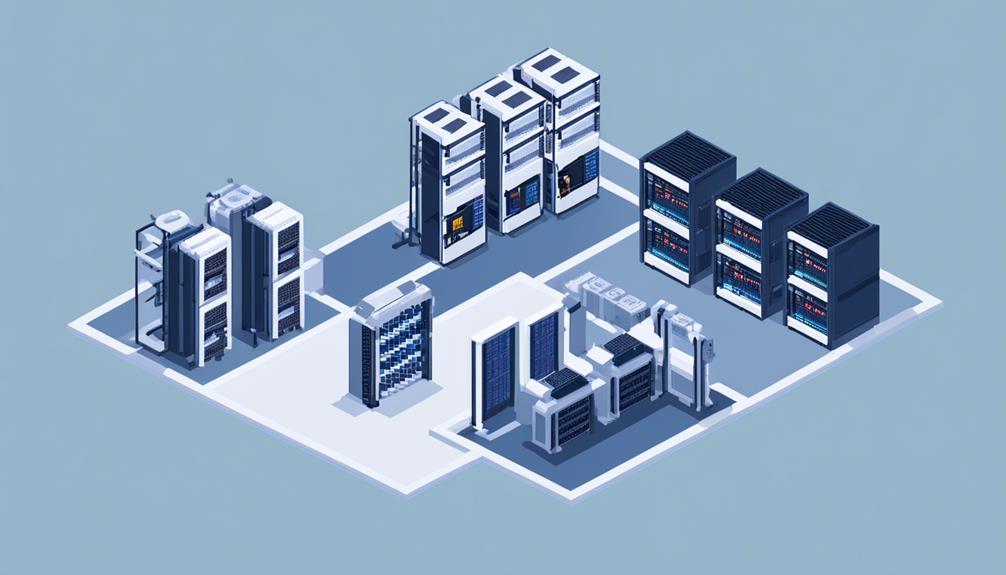
Continuing the focus on ensuring the reliability and performance of backup power systems, the next crucial aspect to discuss is the implementation of redundancy for maximum reliability in data centers.
Implementing redundancy involves having backup systems in place to avoid single points of failure and ensure uninterrupted power supply. Here are four key considerations when implementing redundancy for backup power systems in data centers:
- Multiple Power Distribution Units (PDUs): Installing multiple PDUs ensures that critical components have multiple layers of backup power. If one PDU fails, the others can seamlessly take over, preventing downtime. Redundant PDUs should be connected to separate power sources to further enhance reliability.
- Backup Generators: Backup generators play a vital role in providing extended power supply during utility outages. Implementing redundancy with multiple generators ensures that if one fails, the others can continue to supply power. Regular maintenance and testing of generators are essential to guarantee their reliability during emergencies.
- Uninterruptible Power Supply (UPS): UPS systems provide immediate power backup when utility power is lost. Implementing redundancy with redundant UPS units ensures that if one fails, the others can continue to supply power to critical loads. Additionally, redundant UPS units should be connected to separate power sources and have their own backup batteries for maximum reliability.
- Switchgear and Automatic Transfer Switches (ATS): Switchgear and ATS play a critical role in routing power to critical loads during utility outages. Implementing redundancy with redundant switchgear and ATS ensures that if one fails, the backup systems can seamlessly take over and maintain uninterrupted power supply.
Implementing redundancy is essential to prevent system downtime and ensure maximum reliability for data centers. By having backup systems in place and following best practices for redundancy, data centers can minimize the risk of power failures and maintain uninterrupted operations, safeguarding critical data and ensuring business continuity.
Case Studies: Successful Backup Power Implementations
Case studies provide valuable insights into the successful implementation of backup power systems in data centers, showcasing their critical role in maintaining operational continuity and mitigating potential risks.
One such case study involves the Dalton, Georgia Data Center, which utilized Generac Gensets in conjunction with Toshiba/Eaton UPS and Asco ATS to ensure continuous and reliable power for its energy-intensive operations. This implementation demonstrates the importance of a comprehensive backup power solution that combines multiple components to provide seamless power supply during outages or emergencies.
Another notable case study involves the Farmers Insurance Group, a Fortune 500 company with over $12 billion in revenue. In their successful project, the company benefited from full-service asset recovery and removal, highlighting the importance of proper planning and execution when implementing backup power systems in data centers. This case study underscores the need for a holistic approach that includes not only the installation of backup power equipment but also the removal and disposal of outdated or non-functioning infrastructure.
These case studies serve as real-world examples of how backup power systems can be effectively implemented in data centers. By learning from these successful implementations, data center operators can gain valuable insights and best practices for ensuring uninterrupted power supply.
The critical role of backup power systems in maintaining operational continuity and mitigating potential risks is evident from these case studies. As data centers continue to play a crucial role in today's digital landscape, ensuring reliable and continuous power is paramount to avoid costly downtime and uphold service level agreements.
Best Practices for Backup Power System Installation
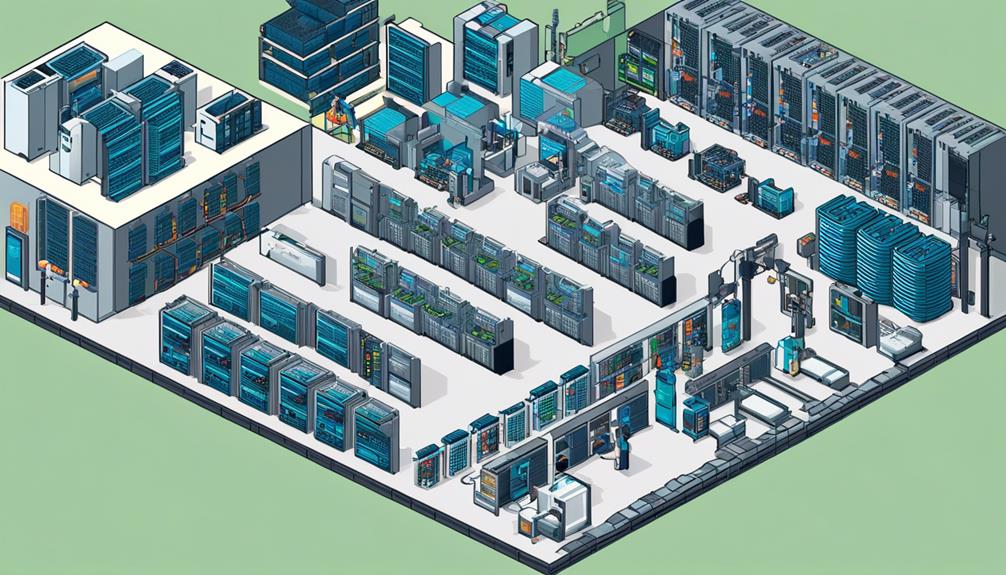
To ensure optimal performance and reliability, the installation of a backup power system in a data center requires meticulous planning and adherence to industry best practices. Here are four key best practices to consider when installing a backup power system:
- Size the system appropriately: It is crucial to ensure that the backup power system is sized accurately to meet the data center's power needs. An undersized system may not provide sufficient power during utility outages, leading to potential disruptions and data loss. Conversely, an oversized system can result in unnecessary costs and inefficiencies. Thoroughly evaluate the data center's power requirements and consult with experts to determine the appropriate capacity.
- Implement redundancy: Redundancy is essential to eliminate single points of failure and enhance the reliability of the backup power system. This can be achieved by incorporating redundant components such as uninterruptible power supplies (UPS) and automatic transfer switches (ATS). Redundancy ensures that power will seamlessly transfer to the backup system in case of a utility outage, minimizing downtime and safeguarding critical data.
- Include a generator: A backup power system should include a generator to provide reliable power during extended utility outages. The generator should be properly sized and maintained to ensure it can handle the data center's power requirements. Regular testing and maintenance are vital to ensure the generator starts promptly and operates smoothly when needed.
- Establish clear operational processes: Clearly define the operational processes for the backup power system, including UPS power supply, generator activation, and switchgear routing to critical loads. This ensures that all personnel involved understand their roles and responsibilities during power outages. Regular training and drills should be conducted to familiarize staff with the procedures and identify any potential issues.
Future Trends in Backup Power Systems for Data Centers
The evolving landscape of data centers necessitates a discussion on the future trends in backup power systems to meet the increasing demand for uninterrupted and efficient power supply. With technological advancements and the growing importance of reliable operations, the demand for uninterrupted power in data centers is on the rise. To address this need, backup power solutions are being designed to provide scalable and efficient power supply.
One of the key components of backup power systems for data centers is the automatic transfer switch (ATS), which routes power between the utility grid and the backup power sources. In the future, ATS systems are expected to become more advanced, incorporating smart technologies that can intelligently manage power flow and optimize energy usage.
Uninterruptible power supplies (UPS) are another crucial element of backup power systems. In the future, UPS systems are likely to become more efficient and compact, enabling data centers to maximize their power backup capabilities while minimizing the physical space required for installation.
Generator sets, particularly diesel gensets, are commonly used as backup power sources in data centers. In the future, there will be a focus on enhancing the efficiency and sustainability of these generator sets. This may involve the adoption of cleaner fuel alternatives, such as natural gas or renewable energy sources, to reduce emissions and environmental impact.
Frequently Asked Questions
What Is the Best Data Center Power Backup?
The best data center power backup solution incorporates a combination of best practices, power redundancy, and advanced battery technology.
By implementing redundant power sources, such as dual utility feeds and multiple backup generators, data centers can ensure uninterrupted power supply.
Additionally, employing advanced battery technologies, such as lithium-ion batteries, can provide longer backup durations and faster recharge times.
This comprehensive approach minimizes downtime and maximizes the reliability of data center power backup systems.
What Is Data Center Backup Power?
Data center backup power refers to the infrastructure and systems in place to provide uninterrupted power supply to critical components during power outages or interruptions. It is essential for ensuring continuous operation and preventing downtime in data centers.
The importance of redundancy is paramount in backup power systems, with backup generators, UPS units, and switchgear playing key roles in providing seamless transitions and continuous power supply.
These systems are designed to prevent data corruption, system restarts, and loss of in-process information, maintaining operational efficiency.
What Type of UPS Do Data Centers Use?
Data centers rely on various types of Uninterruptible Power Supply (UPS) systems for backup power. These UPS systems are critical components of data center infrastructure and play a vital role in protecting servers from downtime.
Data centers typically utilize static or dynamic UPS systems, along with diesel gensets, to ensure reliable backup power solutions. These UPS systems are designed to deliver consistent and efficient power, seamlessly integrating into data center operations.
Having reliable backup power is crucial for preventing system downtime and safeguarding against data loss.
Do Data Centers Have Backup Generators?
Yes, data centers often have backup generators as part of their backup power options. These generators are crucial for ensuring uninterrupted power supply to critical components during interruptions in the main power source.
The importance of backup power cannot be overstated, as power interruptions can lead to system downtimes, startup issues, corruption of parts, and loss of in-process information.
However, implementing backup power systems in data centers can pose challenges, such as managing power spikes during switching to emergency power.
